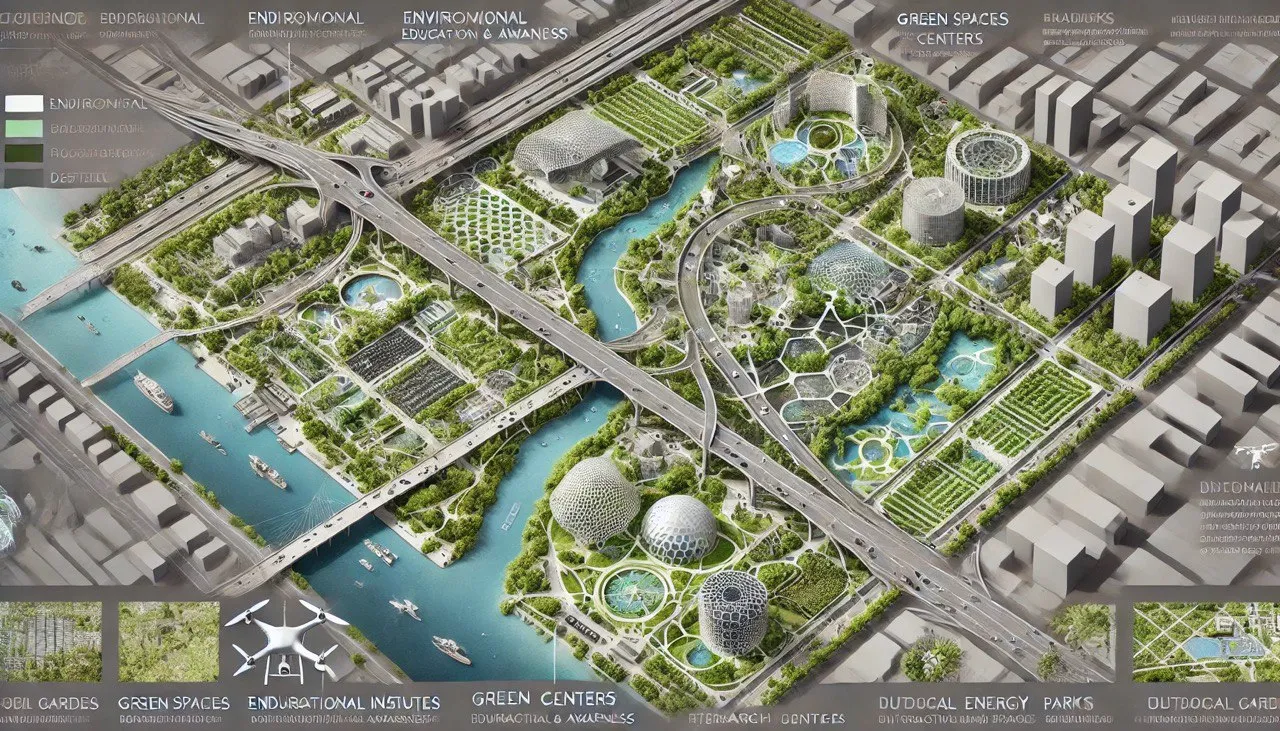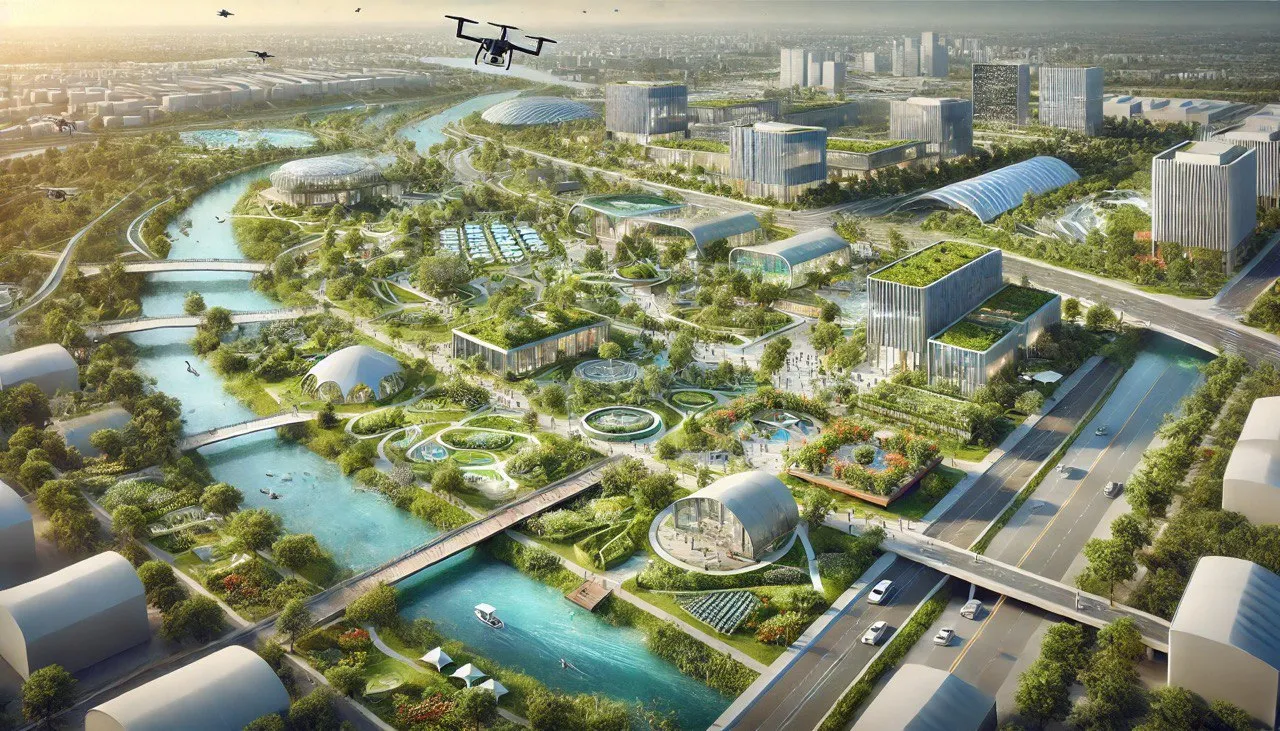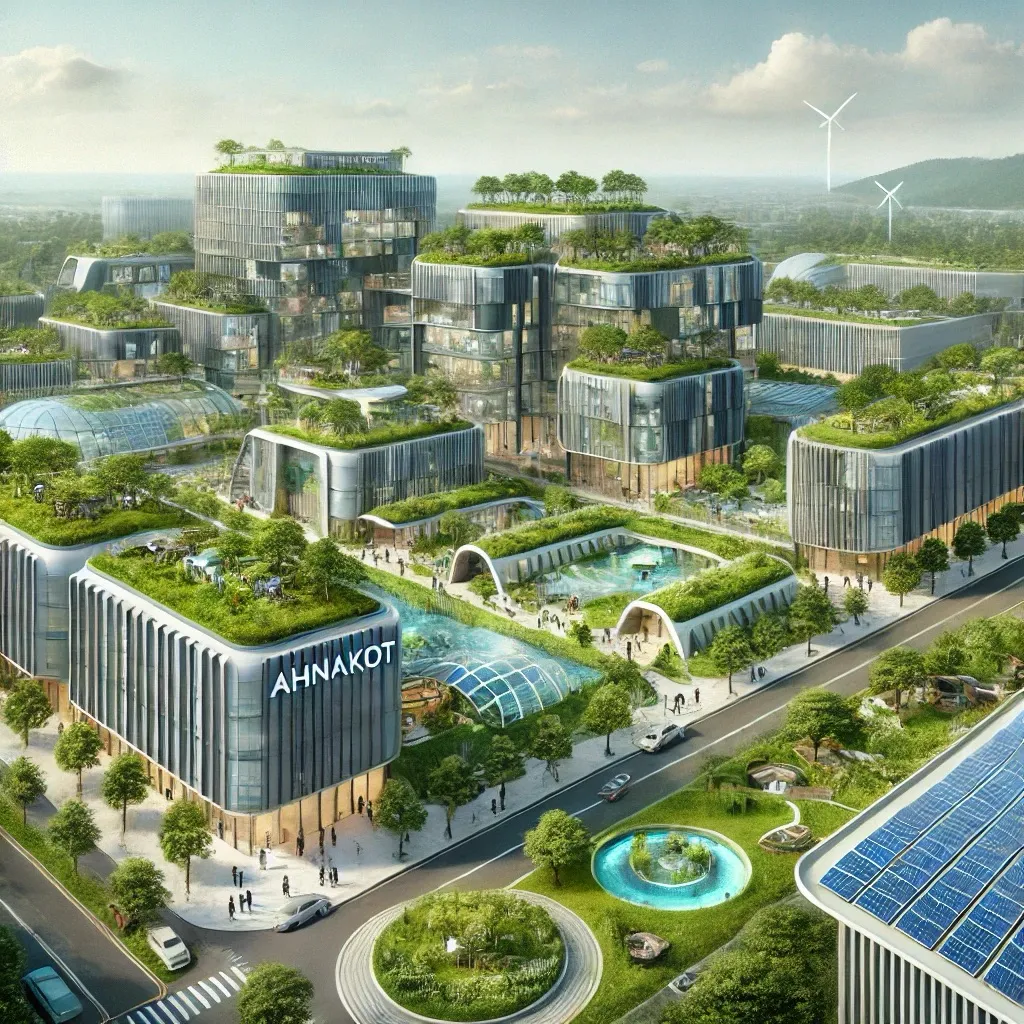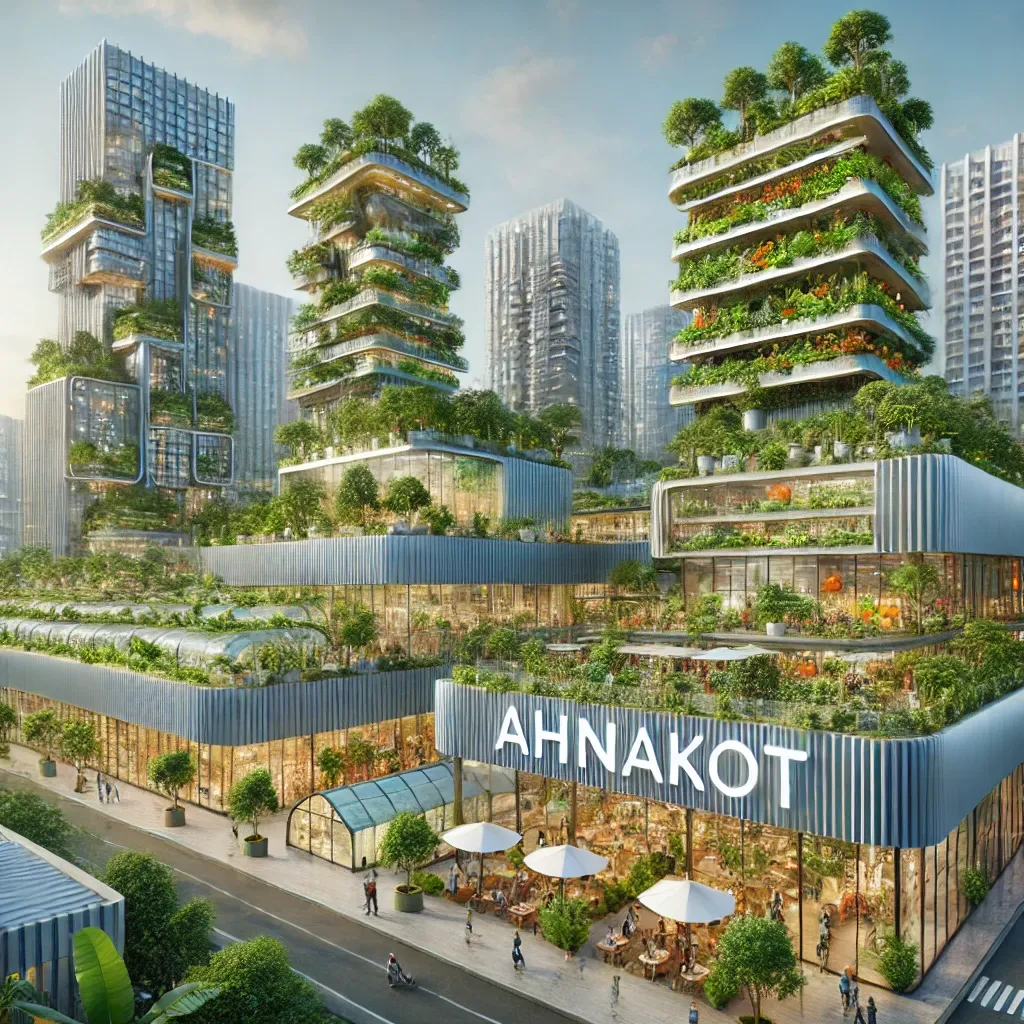AHNAKOT
Environmental Education and Awareness District
The AHNAKOT Environmental Education and Awareness District concept is envisioned as a hub dedicated to promoting environmental education, sustainability practices, and raising awareness about the importance of preserving our natural resources. This district is designed to be a model of eco-friendly living, integrating educational facilities with sustainable urban planning and green technologies.
Key Features:
Environmental Education and Awareness District
1. Educational Centers
- Environmental Institutes: The district hosts institutes and research centers focused on environmental studies, renewable energy, climate change, and sustainable practices. These centers collaborate with schools, universities, and global experts to advance knowledge and solutions for environmental challenges.
- Interactive Museums and Exhibits: Interactive museums and exhibits educate visitors about the environment, biodiversity, and conservation. These facilities are designed to be engaging for all ages, utilizing virtual reality, hands-on exhibits, and outdoor learning spaces.
2. Green Infrastructure
- Sustainable Buildings: All buildings within the district are designed with green building practices, using renewable energy sources such as solar panels, wind turbines, and rainwater harvesting systems. The architecture emphasizes energy efficiency, natural lighting, and reduced carbon footprints.
- Eco-friendly Transportation: The district promotes the use of electric vehicles, bicycles, and pedestrian pathways. Public transportation options are powered by renewable energy, and charging stations for electric vehicles are conveniently located throughout the area.
3. Urban Nature Integration
- Community Gardens and Green Spaces: The district is abundant with community gardens, parks, and green spaces, providing residents and visitors with access to nature. These areas serve as both recreational spaces and outdoor classrooms for environmental education.
- Biodiversity Corridors: Special corridors are designed to promote biodiversity, allowing native flora and fauna to thrive within the urban environment. These corridors connect larger natural reserves to the urban landscape.
4. Sustainability Demonstration Projects
- New Tab- Eco-villages and Green Housing: The district features eco-villages or green housing projects that demonstrate sustainable living. These communities showcase practices like permaculture, greywater recycling, and zero-waste living.
- Renewable Energy Farms: Small-scale renewable energy farms, such as solar parks or wind farms, are integrated into the district to provide clean energy and serve as educational resources for visitors.
5. Community Involvement and Programs
- Workshops and Seminars: Regular workshops and seminars are organized to educate the public on topics such as energy conservation, waste reduction, and sustainable living. These programs aim to empower individuals to make environmentally conscious choices.
- Volunteer Programs: The district encourages community involvement through volunteer programs focused on environmental conservation, urban farming, and sustainability initiatives.
6. Digital and Visual Identity
- Green Signage and Information Kiosks: The name "AHNAKOT" is prominently displayed throughout the district on buildings, digital billboards, and information kiosks. These signs are integrated into the landscape, reinforcing the district's identity as a center for environmental education.
- Sustainable Marketing: The district utilizes sustainable materials and eco-friendly methods in all marketing and informational materials, ensuring that the message of sustainability is consistent across all platforms
Visual Representation
- The images that can be created for the AHNAKOT Environmental Education and Awareness District will depict a green, vibrant urban area with a strong focus on sustainability and education. Expect to see modern, eco-friendly architecture, lush green spaces, community gardens, and educational facilities, all with the name "AHNAKOT" prominently featured. The visuals will capture the essence of a district that is both a center for learning and a model for sustainable living.
Project Portal Link
-
PROJECT SECTOR 1
- 1.Affordable Housing District
- 2.African Harbor District
- 3.Agricultural and Food Production District
- 4.Agriculture and Livestock District
- 5.AIRPORT
- 6.Arabic Harbor District
- 7. AREYATHOR KHMER District
- 8.Buddhism Park History
- 9.Cambodian Historical and Cultural Museum
- 10.CENTRAL BUSINESS DISTRICT (CBD)
- 11.Christian Park History
- 12.City-Wide Integration and Features
- 13.Cultural and Arts District
- 14.Digital and Communications District
- 15.Education and Knowledge District
- 16.Entertainment and Media District
- 17.Environmental Education and Awareness District
-
PROJECT SECTOR 2
- 18.Environmental Research and Development District
- 19.Environmental Conservation District
- 20.Financial District
- 21.French Harbor District
- 22.Government and Administrative District
- 23.Greek Harbor District
- 24.Green Energy and Sustainability District
- 25.Health and Wellness District
- 26.HINDUISM PARK HISTORY
- 27.Historical and Heritage District
- 28.Innovation and Research District
- 29.Islamic History Park
- 31.Japanese Harbor District
- 32.Judaism Park History
- 33.Khmer Harbor District
- 34.Lake Tower District
- 35.Luxury Residential District
-
PROJECT SECTOR 3
- 36.MARINA DISTRICT
- 37.Mexican Harbor District
- 38.Museum Of The Future
- 39.Portuguese Harbor District
- 40.Public Services and Infrastructure District
- 41.Residential Districts
- 42.Retail and Commerce District
- 43.Smart Industrial and Manufacturing District
- 44.Smart Mobility and Transportation District
- 45.Smart Technology and AI District
- 46.Sports and Recreation District
- 47.Tech and Innovation District
- 48.Tourism and Hospitality District
- 49.Transport and Logistics District
- 50.Urban Agriculture and Food Security District V
- 51.Urban Design and Architecture District
- 52.Waterfront District
Project Portal Link
-
PROJECT SECTOR 1
- 1.Affordable Housing District
- 2.African Harbor District
- 3.Agricultural and Food Production District
- 4.Agriculture and Livestock District
- 5.AIRPORT
- 6.Arabic Harbor District
- 7. AREYATHOR KHMER District
- 8.Buddhism Park History
- 9.Cambodian Historical and Cultural Museum
- 10.CENTRAL BUSINESS DISTRICT (CBD)
- 11.Christian Park History
- 12.City-Wide Integration and Features
- 13.Cultural and Arts District
- 14.Digital and Communications District
- 15.Education and Knowledge District
- 16.Entertainment and Media District
- 17.Environmental Education and Awareness District
-
PROJECT SECTOR 2
- 18.Environmental Research and Development District
- 19.Environmental Conservation District
- 20.Financial District
- 21.French Harbor District
- 22.Government and Administrative District
- 23.Greek Harbor District
- 24.Green Energy and Sustainability District
- 25.Health and Wellness District
- 26.HINDUISM PARK HISTORY
- 27.Historical and Heritage District
- 28.Innovation and Research District
- 29.Islamic History Park
- 31.Japanese Harbor District
- 32.Judaism Park History
- 33.Khmer Harbor District
- 34.Lake Tower District
- 35.Luxury Residential District
-
PROJECT SECTOR 3
- 36.MARINA DISTRICT
- 37.Mexican Harbor District
- 38.Museum Of The Future
- 39.Portuguese Harbor District
- 40.Public Services and Infrastructure District
- 41.Residential Districts
- 42.Retail and Commerce District
- 43.Smart Industrial and Manufacturing District
- 44.Smart Mobility and Transportation District
- 45.Smart Technology and AI District
- 46.Sports and Recreation District
- 47.Tech and Innovation District
- 48.Tourism and Hospitality District
- 49.Transport and Logistics District
- 50.Urban Agriculture and Food Security District V
- 51.Urban Design and Architecture District
- 52.Waterfront District
Contact us
Discover what’s possible with Understood
Project Portal Link
-
PROJECT SECTOR 1
- 1.Affordable Housing District
- 2.African Harbor District
- 3.Agricultural and Food Production District
- 4.Agriculture and Livestock District
- 5.AIRPORT
- 6.Arabic Harbor District
- 7. AREYATHOR KHMER District
- 8.Buddhism Park History
- 9.Cambodian Historical and Cultural Museum
- 10.CENTRAL BUSINESS DISTRICT (CBD)
- 11.Christian Park History
- 12.City-Wide Integration and Features
- 13.Cultural and Arts District
- 14.Digital and Communications District
- 15.Education and Knowledge District
- 16.Entertainment and Media District
- 17.Environmental Education and Awareness District
-
PROJECT SECTOR 2
- 18.Environmental Research and Development District
- 19.Environmental Conservation District
- 20.Financial District
- 21.French Harbor District
- 22.Government and Administrative District
- 23.Greek Harbor District
- 24.Green Energy and Sustainability District
- 25.Health and Wellness District
- 26.HINDUISM PARK HISTORY
- 27.Historical and Heritage District
- 28.Innovation and Research District
- 29.Islamic History Park
- 31.Japanese Harbor District
- 32.Judaism Park History
- 33.Khmer Harbor District
- 34.Lake Tower District
- 35.Luxury Residential District
-
PROJECT SECTOR 3
- 36.MARINA DISTRICT
- 37.Mexican Harbor District
- 38.Museum Of The Future
- 39.Portuguese Harbor District
- 40.Public Services and Infrastructure District
- 41.Residential Districts
- 42.Retail and Commerce District
- 43.Smart Industrial and Manufacturing District
- 44.Smart Mobility and Transportation District
- 45.Smart Technology and AI District
- 46.Sports and Recreation District
- 47.Tech and Innovation District
- 48.Tourism and Hospitality District
- 49.Transport and Logistics District
- 50.Urban Agriculture and Food Security District V
- 51.Urban Design and Architecture District
- 52.Waterfront District
Project Portal Link
-
PROJECT SECTOR 1
- 1.Affordable Housing District
- 2.African Harbor District
- 3.Agricultural and Food Production District
- 4.Agriculture and Livestock District
- 5.AIRPORT
- 6.Arabic Harbor District
- 7. AREYATHOR KHMER District
- 8.Buddhism Park History
- 9.Cambodian Historical and Cultural Museum
- 10.CENTRAL BUSINESS DISTRICT (CBD)
- 11.Christian Park History
- 12.City-Wide Integration and Features
- 13.Cultural and Arts District
- 14.Digital and Communications District
- 15.Education and Knowledge District
- 16.Entertainment and Media District
- 17.Environmental Education and Awareness District
-
PROJECT SECTOR 2
- 18.Environmental Research and Development District
- 19.Environmental Conservation District
- 20.Financial District
- 21.French Harbor District
- 22.Government and Administrative District
- 23.Greek Harbor District
- 24.Green Energy and Sustainability District
- 25.Health and Wellness District
- 26.HINDUISM PARK HISTORY
- 27.Historical and Heritage District
- 28.Innovation and Research District
- 29.Islamic History Park
- 31.Japanese Harbor District
- 32.Judaism Park History
- 33.Khmer Harbor District
- 34.Lake Tower District
- 35.Luxury Residential District
-
PROJECT SECTOR 3
- 36.MARINA DISTRICT
- 37.Mexican Harbor District
- 38.Museum Of The Future
- 39.Portuguese Harbor District
- 40.Public Services and Infrastructure District
- 41.Residential Districts
- 42.Retail and Commerce District
- 43.Smart Industrial and Manufacturing District
- 44.Smart Mobility and Transportation District
- 45.Smart Technology and AI District
- 46.Sports and Recreation District
- 47.Tech and Innovation District
- 48.Tourism and Hospitality District
- 49.Transport and Logistics District
- 50.Urban Agriculture and Food Security District V
- 51.Urban Design and Architecture District
- 52.Waterfront District













